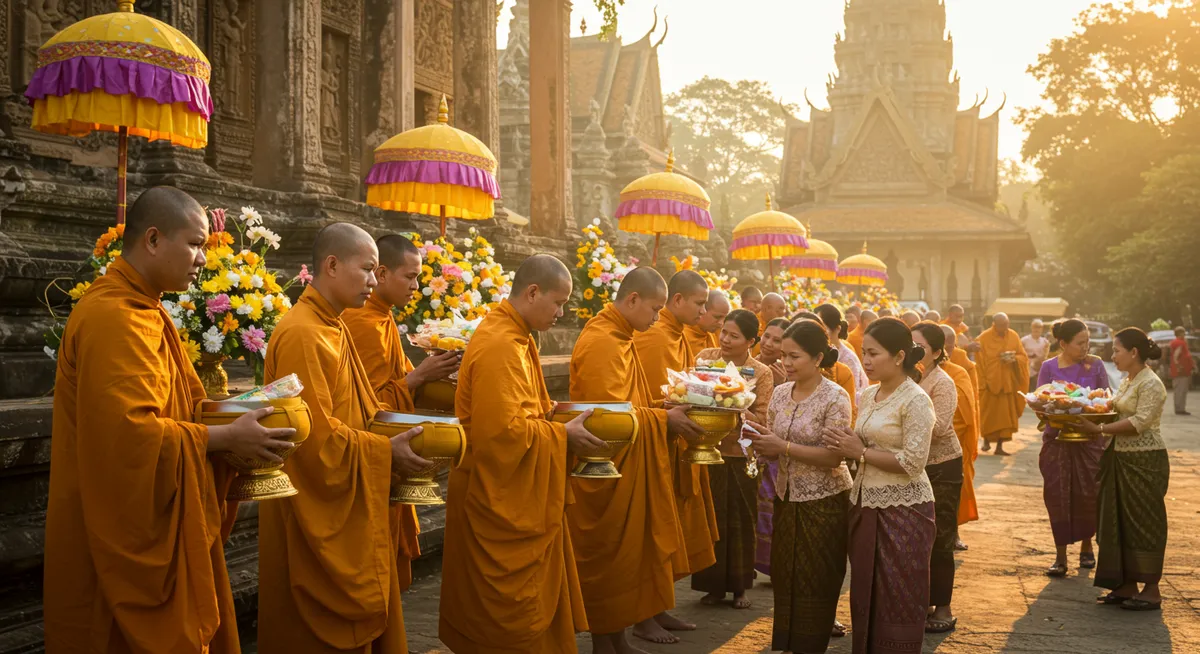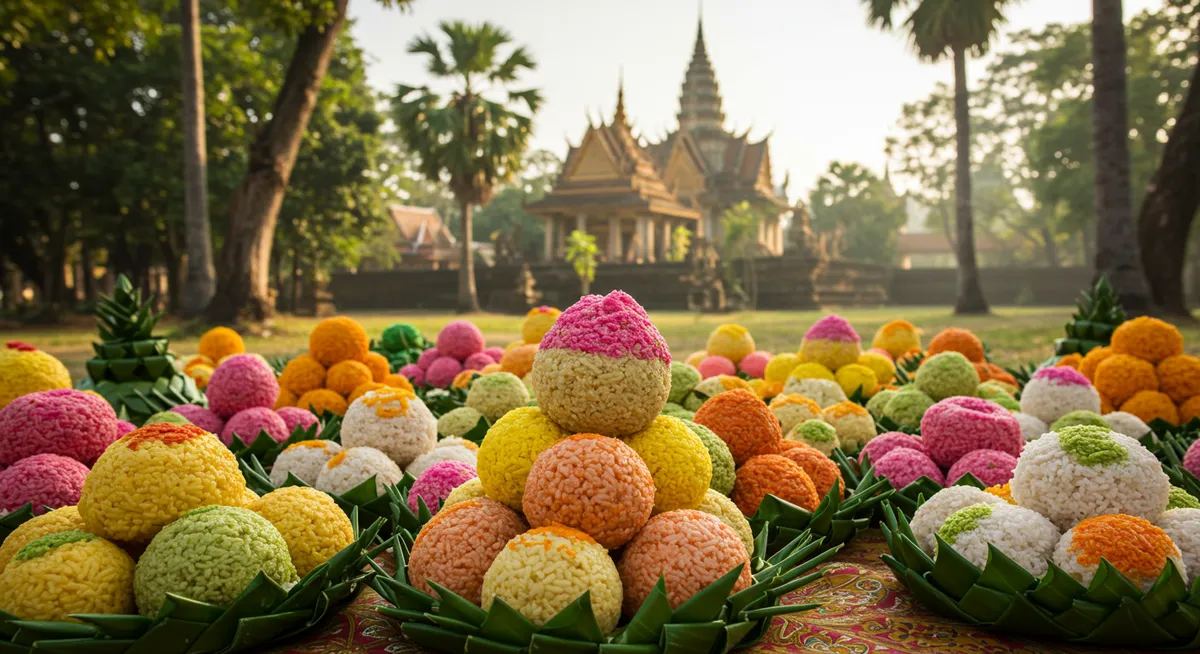Pchum Ben Guide | Cambodia's Sacred Festival of the Dead

Pchum Ben: Cambodia's Sacred Festival of Ancestral Devotion
For fifteen days each autumn, Cambodia observes one of its most significant spiritual events as temples fill with devotees bearing offerings for departed ancestors. Pchum Ben, often translated as the "Gathering of Rice Balls" or the "Festival of the Dead," represents a profound expression of Cambodia's interconnected Buddhist faith, ancestral reverence, and community solidarity. During this sacred period, Cambodians believe the gates between the worlds of the living and dead temporarily open, allowing departed souls to receive offerings and blessings from their descendants. This guide explores the spiritual significance, historical context, and ceremonial practices of this uniquely Cambodian celebration that serves as a living bridge between generations past and present.

The Spiritual Significance of Pchum Ben
Beyond its ceremonial practices, Pchum Ben embodies profound cultural and spiritual values:
- Familial Obligation: The festival reinforces the Cambodian belief in ongoing responsibility toward ancestors
- Merit Transfer: Living descendants generate spiritual merit (karma) to share with departed relatives
- Cosmic Balance: Proper observance ensures ancestors don't become hungry ghosts (preta) wandering in suffering
- Community Solidarity: The shared rituals strengthen bonds within villages and across society
- Cultural Identity: Pchum Ben traditions reinforce Khmer heritage and collective memory
Historical and Religious Context
Pchum Ben reflects Cambodia's complex spiritual heritage:
- Ancient Origins: Elements of ancestral veneration predate the arrival of Buddhism in Cambodia
- Buddhist Integration: The festival incorporates Theravada Buddhist concepts of merit and rebirth
- Brahmanic Influences: Hindu elements remain from Cambodia's historical religious syncretism
- Historical Disruption: The Khmer Rouge period (1975-1979) temporarily suppressed religious practices
- Modern Revival: Post-conflict restoration of the festival as an important cultural touchstone
The Fifteen-Day Observance
Pchum Ben unfolds as a carefully structured ceremonial sequence:
Kan Ben (First Fourteen Days)
The preliminary two weeks establish the ritual foundation:
- Village Rotation: Communities take turns making offerings at local pagodas on assigned days
- Dawn Visits: Early morning temple attendance to present food and prayers
- Monk Blessings: Religious officials chant sutras to guide offerings to the ancestors
- Gradual Buildup: Ceremonies grow more elaborate as the festival progresses
Pchum Ben (Final Day)
The culminating day features the most significant rituals:
- Mass Temple Attendance: Families gather at pagodas in formal attire bearing elaborate offerings
- Bay Ben Ceremony: Ritual scattering of rice balls (bay ben) in temple grounds
- Special Prayers: Extended chanting sessions led by senior monks
- Ancestral Invocation: Formal calling of departed relatives by name to receive offerings
- Community Celebration: Large communal meals and cultural performances

Key Ceremonial Elements
Several distinctive practices define Pchum Ben observances:
Food Offerings
Carefully prepared foods form the heart of ancestral offerings:
- Rice Balls (Bay Ben): Sticky rice formed into small balls, sometimes with sesame seeds
- Num Ansom: Cylindrical sticky rice cakes wrapped in banana leaves with sweet or savory fillings
- Five Types of Ritual Foods: Traditional combinations of dishes with symbolic meanings
- Monk's Meals: Special food preparations donated to temple residents
- Seasonal Fruits: Fresh local produce arranged on offering platters
Pagoda Rituals
Temple ceremonies follow specific protocols:
- Preah Sangha Thean: Offerings to the monastic community who serve as intermediaries to ancestors
- Bangskol: Special recitation of protective texts and blessings
- Ancestral Naming: Formal recitation of seven generations of ancestors' names
- Circumnambulation: Walking clockwise around temple buildings with offerings
- Incense and Candles: Lighting symbolic flames to guide ancestral spirits
Home Preparations
Families undertake special preparations at home:
- Home Cleaning: Thorough house cleaning to welcome ancestral spirits
- Domestic Altars: Setting up or refreshing family shrines with photos of departed relatives
- Special Cooking: Multiple generations gathering to prepare traditional foods
- New Clothing: Purchasing formal attire for temple visits
- Family Gatherings: Relatives returning to ancestral villages for the observance
Ancestral Beliefs and Cosmology
The festival reflects Cambodia's distinctive spiritual worldview:
- Temporary Return: Belief that ancestors temporarily leave the afterlife to seek offerings
- Seven Generations: Responsibility to honor ancestors up to seven generations back
- Hungry Ghosts: Concern for ancestors who might suffer as preta due to karma or lack of offerings
- Merit Transfer: Living descendants can improve ancestors' spiritual status through good deeds
- Spiritual Protection: Proper observance ensures blessings and protection from ancestors

Regional Variations
While following common elements, Pchum Ben practices vary across Cambodia:
- Rural Traditions: Village celebrations maintain more traditional elements with extended ceremonies
- Urban Adaptations: City observances often accommodate work schedules with condensed rituals
- Provincial Specialties: Different regions feature distinctive food offerings and local customs
- Royal Ceremonies: The royal family conducts special observances with courtly traditions
- Ethnic Variations: Khmer Krom, Chinese-Khmer, and other groups incorporate their cultural elements
Contemporary Pchum Ben
The festival continues to evolve in modern Cambodia:
Social Dimensions
Beyond religious observance, Pchum Ben serves important social functions:
- Urban-Rural Return: Major internal migration as city dwellers return to ancestral villages
- Family Reunions: Opportunity for extended families to reconnect across generations
- Knowledge Transmission: Elders teaching younger generations about cultural practices
- Community Solidarity: Shared responsibility for temple upkeep and ceremony organization
- Social Status: Opportunity to demonstrate family prosperity through generous offerings
Economic Impact
The festival creates significant economic activity:
- Agricultural Demand: Increased consumption of rice, fruits, and ceremonial ingredients
- Textile and Clothing: Purchases of new traditional clothing for temple visits
- Transportation Surge: Heavy travel throughout the country during the fifteen days
- Temple Donations: Major source of financial support for Cambodia's religious institutions
- Tourism Opportunity: Growing interest from international visitors in authentic cultural experiences
Cultural Preservation Challenges
Modern life presents both opportunities and challenges for traditional practices:
- Urbanization Effects: Migration to cities creates logistical challenges for extended observances
- Youth Engagement: Efforts to maintain interest among younger generations
- Documentation: Formal recording of traditional practices that were historically oral
- International Recognition: Promotion of Pchum Ben as intangible cultural heritage
- Diaspora Connections: Cambodians overseas maintaining traditional practices
Experiencing Pchum Ben as a Visitor
For travelers, Pchum Ben offers unique cultural insights:
Visitor Etiquette
Respectful participation requires cultural awareness:
- Modest Dress: Covered shoulders and knees required for temple visits
- Quiet Observation: Maintaining respectful silence during ceremonies
- Photography Consent: Asking permission before photographing ceremonies or individuals
- Participation Boundaries: Some rituals may be reserved for family members only
- Temple Donations: Small offerings are welcome but not required from visitors
Notable Locations
Certain venues offer particularly meaningful Pchum Ben experiences:
- Wat Phnom (Phnom Penh): The capital's ancient founding temple hosts significant ceremonies
- Oudong: Former royal capital with special historical significance
- Battambang Temples: Provincial celebrations with distinctive local traditions
- Rural Pagodas: Village temples often feature more traditional, less crowded observances
- Silver Pagoda: Royal observances at the palace compound
Planning your Pchum Ben experience?
Pchum Ben follows the Khmer lunar calendar, typically falling in September or October. The dates change annually, so check with Cambodian tourism authorities for the exact schedule.
For the most meaningful experience, consider visiting both urban temples like those in Phnom Penh and smaller provincial pagodas to witness the full spectrum of ceremonial practices.
Explore Related Asian Ancestral Traditions
If you're interested in Pchum Ben, discover these related ancestral veneration festivals across Asia:
Ghost Festival
East Asian tradition honoring ancestors and appeasing wandering spirits with offerings.
Obon Festival
Japanese Buddhist celebration to honor ancestral spirits with lanterns and traditional dance.
Chuseok
Korean harvest festival featuring ancestral ceremonies and traditional foods.
Qingming Festival
Chinese tomb-sweeping day for honoring ancestors at gravesites with offerings.
Gai Jatra
Nepalese festival honoring the deceased with cow processions and community humor.
Tiwah Ceremony
Dayak funeral ritual in Borneo to guide souls to the afterlife.
Each ancestral festival in Asia reflects unique cultural approaches to death and remembrance. While Pchum Ben focuses on offering food, service and merit to departed ancestors, Ghost Festival focuses on appeasing wandering spirits, and Mid-Autumn Festival welcomes ancestors back home with lanterns and dance. These festivals reveal how different cultures maintain connections with those who came before.